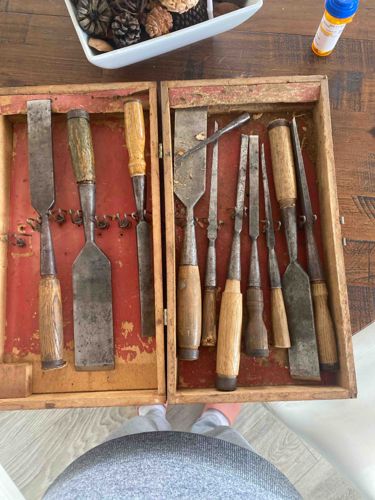
Antique Chisel Set in Wooden Cases
This item comprises two wooden cases, each containing a collection of antique chisels, likely for woodworking or carving. The cases themselves appear to be constructed from light-colored wood, possibly pine or a similar soft wood, with simple butt joints or finger joints visible at the corners. The interior of the cases is lined with a reddish-orange material, possibly felt or a painted surface, which shows significant wear, chipping, and discoloration, revealing the bare wood beneath. Small metal hooks or staples are embedded in the lining, suggesting they were intended to hold the chisels securely in place, though many appear to be missing or bent. The chisels vary significantly in size and shape, indicating a diverse set of tools for different tasks. The blades are made of steel and exhibit considerable rust, pitting, and general oxidation, consistent with age and prolonged storage in potentially damp conditions. Some blades show remnants of a darker patina, while others have lighter, more active rust. The cutting edges, where visible, appear blunt and would require significant re-sharpening for practical use. The handles are predominantly made of wood, varying in color from light tan to darker, aged brown. Several handles show visible grain patterns, and some have distinct wear patterns, cracks, or chips, suggesting extensive use. One handle on the left, for instance, has a greenish-brown, almost mottled appearance, possibly from a different type of wood or an applied finish that has worn unevenly. Another handle in the right case is distinctly lighter and appears to be made of a blonder wood. The tangs of the chisels, where the metal meets the handle, show varying degrees of corrosion and some seem to be held in place with ferules, while others appear to be driven directly into the wood. The overall aesthetic is one of substantial age and a working history, rather than ornamental display. The tools likely date from the late 19th to early 20th century, given their construction and visible aging.
AI-Generated Appraisal Disclaimer
Estimated Value
$150-250
Basic Information
Category
Antique Tools
Appraised On
November 15, 2025
Estimated Value
$150-250
Item Description
This item comprises two wooden cases, each containing a collection of antique chisels, likely for woodworking or carving. The cases themselves appear to be constructed from light-colored wood, possibly pine or a similar soft wood, with simple butt joints or finger joints visible at the corners. The interior of the cases is lined with a reddish-orange material, possibly felt or a painted surface, which shows significant wear, chipping, and discoloration, revealing the bare wood beneath. Small metal hooks or staples are embedded in the lining, suggesting they were intended to hold the chisels securely in place, though many appear to be missing or bent. The chisels vary significantly in size and shape, indicating a diverse set of tools for different tasks. The blades are made of steel and exhibit considerable rust, pitting, and general oxidation, consistent with age and prolonged storage in potentially damp conditions. Some blades show remnants of a darker patina, while others have lighter, more active rust. The cutting edges, where visible, appear blunt and would require significant re-sharpening for practical use. The handles are predominantly made of wood, varying in color from light tan to darker, aged brown. Several handles show visible grain patterns, and some have distinct wear patterns, cracks, or chips, suggesting extensive use. One handle on the left, for instance, has a greenish-brown, almost mottled appearance, possibly from a different type of wood or an applied finish that has worn unevenly. Another handle in the right case is distinctly lighter and appears to be made of a blonder wood. The tangs of the chisels, where the metal meets the handle, show varying degrees of corrosion and some seem to be held in place with ferules, while others appear to be driven directly into the wood. The overall aesthetic is one of substantial age and a working history, rather than ornamental display. The tools likely date from the late 19th to early 20th century, given their construction and visible aging.
Get Your Items Appraised
Instant estimates of your treasures with AI-powered instant appraisals